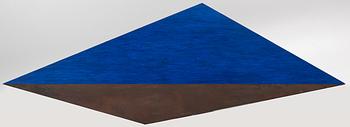Gregory Mahoney
Gregory Mahoney, "Edge-Water"
Signerad Gregory Mahoney och daterad 1983 tergo. Duk/pannå 117 x 365 cm.
Proveniens
Beijer Collection, Stockholm. Inköpt på 90-talet från ovan av nuvarande ägare.
Övrig information
Artforum, November 1987, VOL. 26, NO. 3
At first glance, Gregory Mahoney’s “paintings” appear to draw upon the reductive tenets of hard-edge abstractionists such as Ellsworth Kelly and Leon Polk Smith. Viewed collectively, their impact seems hermetically formal, exploring the basic parameters of the picture plane (shape, edge, surface frontality) as well as the interplay of positive and negative space within the gallery environment as a whole.
On closer examination however, the work discloses references to the natural landscape, particularly the desert, mountains, and ocean of Southern California. Mathematical geometry thus acts as an idealized signifier for more organic concerns, and Mahoney’s habitual vocabulary of dissected diamonds, crescents, circles, and trapezoids suddenly metamorphoses into clearly delineated visual perspectives. Instead of flat cone shapes, for example, we begin to perceive triangular sight lines across endless salt flats that reach out toward a distant horizon, as in Alluvial Reflection or Eclipsed Reflection, both 1987. Similarly, in works such as Axis Eclipse, 1986–87, vertical axes suggest split perspectives, in particular the dislocation or eclipse produced by closing one eye, blinking, or moving one’s head.
Mahoney reinforces this conservative view of the sublime landscape through his use of natural materials and processes. Horizons and axes usually divide shaped segments of oxidized steel from charred wood that has been treated with red, blue, or black pigment, so that the juxtaposition of rusted patinas and rich, amorphous hues might suggest baked desert landscapes, alluvial deposits, or large bodies of water. Although the contrasting textures and warm/cold, hard/soft resonances are clearly important in Mahoney’s attempt to evoke a wide range of emotional responses, they seem less significant than his harnessing of chemical processes whose effects continue after he has assembled his materials into the form of an artwork. By so doing, he attempts to create a true organic synthesis of art and science, subjective vision and objective “reality.”
The philosophical basis for such an esthetic would appear to be the hermeneutical phenomenology of Martin Heidegger. Heidegger propounded the hegemony of organic Being, a transcendental state that blurs all distinction between subjective and objective existence. Interestingly enough, Heidegger shared Mahoney’s affinity for formalist principles, particularly in the notion of de-familiarization, a form of estranging effect that draws attention to the language of the art object/subject and allows its transcendental essence to shine through. The artist thus acts as a sort of unifying agent between the universal (in Mahoney’s case, the landscape and the immutable laws of geometry) and human perception of the universal.
In many ways, the phenomenological view inherent in Mahoney’s work is not far removed from the organic idealism of late 18th-century Romanticism, which also saw redemption in the “truths” of natural forces. Post-Structuralists have had a field day deconstructing such metaphysical concepts, and, viewed simply as a subjective language system, the work’s stylistic rhetoric makes his apparent philosophical and “spiritual” objectives seem arbitrary at best. Moreover, like any idealist esthetic, Mahoney’s presupposes a closed text, and thus encourages a passive and servile response to both art and nature.
Reviewed by Colin Gardner.



































